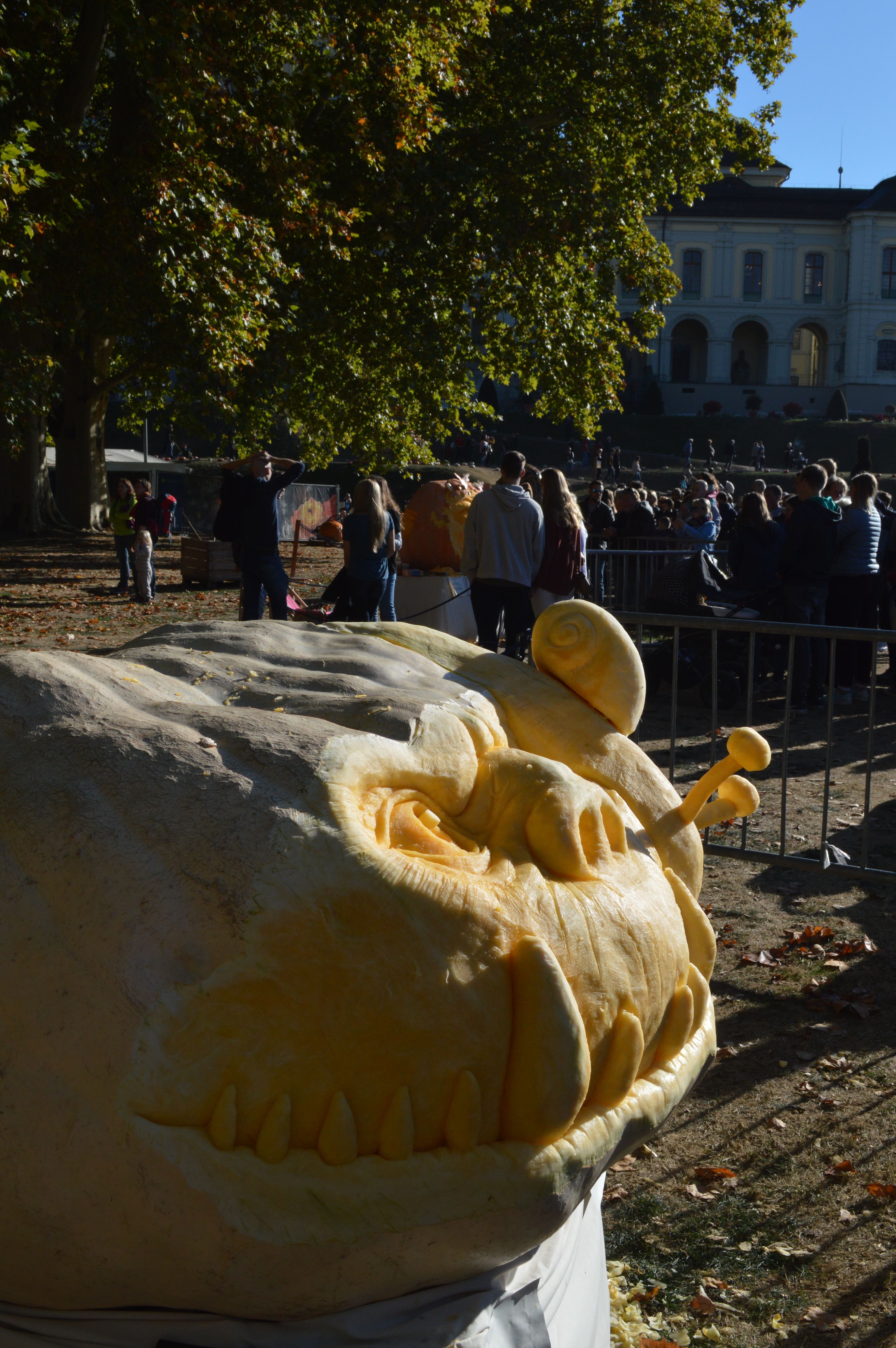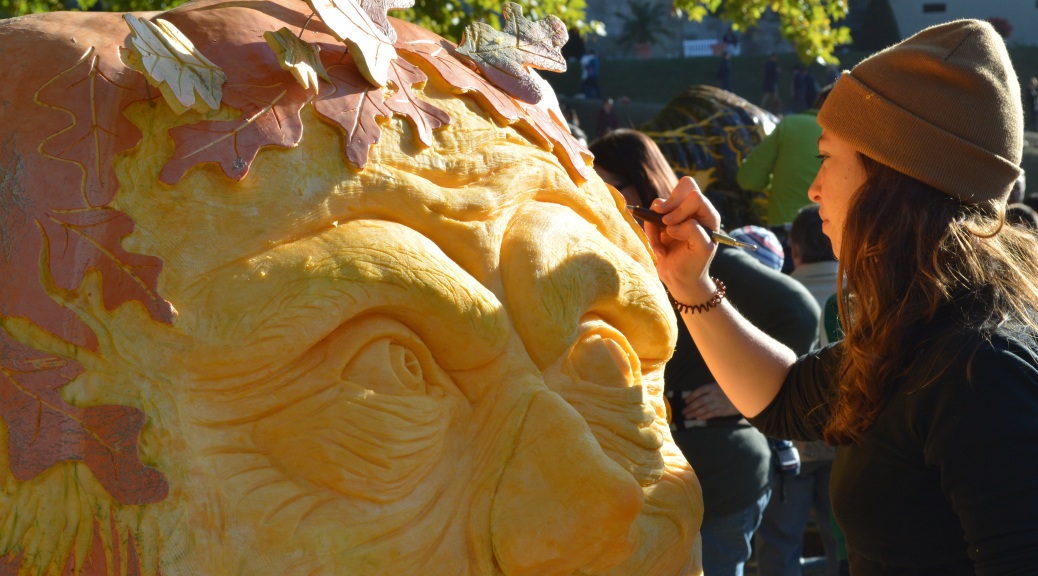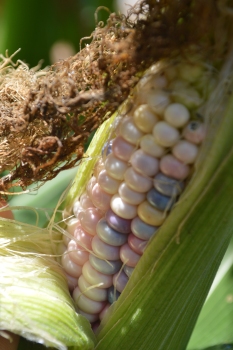In Ludwigsburg Germany, the home of the European Giant Pumpkin Championship, one might think that the competition is simply “winner takes all,” but think again. These other giants undergo a transformation that will leave you speechless.
 I had planned to arrive at Bluhendes Barock, this past Sunday, to watch international sculptors transform giant pumpkins into works of art, but I just couldn’t wait. I decided to go to the festival a day early, so to visit the selected pumpkins before they were paired with an artist.
I had planned to arrive at Bluhendes Barock, this past Sunday, to watch international sculptors transform giant pumpkins into works of art, but I just couldn’t wait. I decided to go to the festival a day early, so to visit the selected pumpkins before they were paired with an artist.
I wasn’t the only one with this strategy. These now accessable giant pumpkins were set out in the gardens, offering a perfect photo opportunity for admiring fans. The pumpkin growers had elected to donate these giant pumpkins for the artists to work with. A fair amout of diversity was represented in the pumpkins themselves, both in their genetics, and from where they came from. The invited artists also came from many different locations: France, Germany, Switzerland and Russia were all represented.
On Sunday, I walked through the leaf filled paths of the Bluhendes Barock gardens, to see the sculptors at work. I quietly admired the athletic actions of these sculptors. They would have only one day to complete these monumental works, so every minute would count. As much as I tried to stay quiet, several of the artists noticed that my admiration exceeded that of most visitors. Perhaps it was the fact that I took over 100 photos, and I continued to watch for hours. I was fortunate that several of the artists offered me some of their precious work time so to welcome me, and gave me an inside look at what it takes to be a pumpkin sculptor. I passed them my business card, filled with images of pumpkins, and instant friendships were made. I told them that I was visiting them from Hawaii, and that it was well worth the trip.
Jeroen van de Vlag of Siebnen, Switzerland, spoke to me about the sand sculptures that decorated the palace grounds, as well as the pumpkin creature he was currently carving. He had created some of the elaborate sand sculptures in the formal palace gardens, back in July. I had marveled at them the day before, and now, even more so, after learning that they had already been outdoors, on display, for three full months of autumn weather. The day prior, I had admired the pumpkin sculpture, but I did not immediately recognize that it was made of sand. What initally caught my eye, was the collection of Long Island Cheese, and Crown pumpkins that decorated the base, then I noticed that the pumpkin sculpture was not cast, but rather an ephemeral work of sand.
Jeroen and I spoke about his life as a travelling sculptor, of ice, fruit, and of sand, before he returned to work on his design. Earlier in the day, a little boy asked the name of his pumpkin creature, and Jeroen named the creature after the little boy. In the process, perhaps another pumpkin sculptor was born.

I moved on to the next sculpture, as the artist, Larissa Bohrkircher, worked intensely on a very different pumpkin face. As she worked, visitors noticibly cheered her on. She worked on a pumpkin which clearly reflected this year’s festival theme of “the forest.”
I took a good look at the tools of the trade, as well as the different techniques the artists were using to make these reductive sculptures. I saw various knives, exacto blades, pruning saws, and also sculpting tools normally used in ceramics. Because of the scale, I also noticed a shovel, pitchfork, and the large bin, containing what was cleaned out of the pumpkins earlier that day. The names of the pumpkin growers were also on display, for they had generously donated their farm treasures for all to enjoy
I have to admit, I wanted to get in on the action, especially after a delightful exchange with Galina Faletra, a Russian born artist, who now resides, and carves in nearby Stuttgart. She was working on a large creature who made everyone smile. She explained to me that she had a new baby, indicating towards the happy face in the nearby stroller. This busy mom did double duty, caring for her baby, as she sculpted a pumpkin creature. I had to smile, thinking that her child will have incredibly high expectations for their Halloween decorations in the years ahead, and I am sure Galina will lovingly exceed those wishes.
Then I saw another crowd gathering as a lanky, contemplative artist returned to her work. She studied the movement of a dragon that curled around the giant pumpkin. She stood back for a good, long look, before stepping in to further reduce the form. As the light played with the shadows, she seemed to be judging how best to bring this dragon into the late afternoon light. Corina Lampropoulos was in her zone.
When viewing sculpture, all sides are considered, and Corina was working on bringing the tail of the dragon into focus. Many viewers were happy to see the unexpected dragon pumpkin. I heard the German word for dragon, drachen, said with delight. I immediately liked this artist’s style, as she created the unexpected with an athleticism mixed with grace.
A man stopped by to comment on Corina’s successful sculpture. I gathered from the pumpkin cuttings that covered him from head to toe, that he must be the artist from France, Benoit Dutherage. They posed for a few photos before both artists returned to thier pumpkins. Several of the people I met that day had mentioned that I should meet Dutherage. He had worked hard to get his sculpture near completion, before stepping away. He was now returning, with “fresh eyes” to complete his work. Benoit displayed a photo of a sleeping infant, that was now also seen carved before us.

The scale of Dutherage’s work was impressive. It wasn’t until he returned to his sculpture that you fully appreciated the monumental work. You could now see how huge the pumpkin was, when compared to a full grown man. He stepped forward to speak to me about sculpture, contests, and the challenges of creating large scale work within one day. We spoke of inspiration, style, and artistic expression before he excused himself so to change his clothes before the judging. I tried to convice him otherwise, as I thought the sculptor’s clothing told a story.

As Dutherage stepped away, so did I, because it was judging time, and I felt that it was best to be impartial. Each of these artists had shared a bit of themselves with me today, and I respected each of them, and their works. I did not have a favorite, but was inspired by all. As I returned to the pumpkin carving garden, the announcer climbed above the crowd to announce the winners. The crowd hushed so to hear the results. Larissa Bohrkircher’s name was announced as the 2018 sculpture winner. She smiled, blushed, and waved to the fans.

I congratulated Larissa, as she offered a broad smile and a thank you. The crowds gathered again, to photograph her and her work. I was pleased to watch as the artists congratulated, and complemented each other’s work. It was clear that they were supportive of each other. I offered my own words of praise to the artists before I left. We exchanged waves, and handshakes, and kisses on both cheeks. As I walked away, I was given the opportunity to collect three giant pumpkin seeds for a friend. For me, as a grower, the action had even a greater significance. This sharing of seeds was the perfect way to share the creativity, magic, and inspiration that transpired that day.

















































































